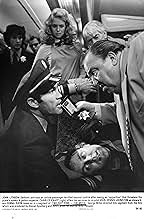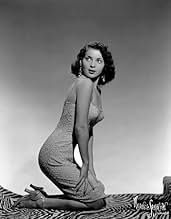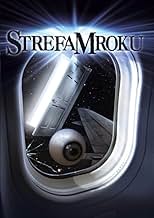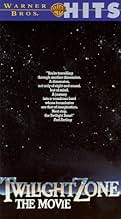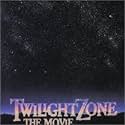NOTE IMDb
6,5/10
43 k
MA NOTE
Quatre épisodes d'horreur et de science-fiction, réalisés par quatre metteurs en scène célèbres, chacun étant une nouvelle version d'un classique de la série télévisée phare de Rod Serling.Quatre épisodes d'horreur et de science-fiction, réalisés par quatre metteurs en scène célèbres, chacun étant une nouvelle version d'un classique de la série télévisée phare de Rod Serling.Quatre épisodes d'horreur et de science-fiction, réalisés par quatre metteurs en scène célèbres, chacun étant une nouvelle version d'un classique de la série télévisée phare de Rod Serling.
- Récompenses
- 1 victoire et 8 nominations au total
Rainer Peets
- German Officer (segment "Time Out")
- (as Remus Peets)
William S. Taylor
- G.I. (segment "Time Out")
- (as William B. Taylor)
Avis à la une
When I first watched this film at the age of seven, I must have been freaked out for weeks. Never had a movie had that kind of effect on my psyche, especially "Nightmare at 20,000 Feet." While some will label this as a bad film due to the fact it didn't faithfully reproduce the original stories very well. I say 'Who Cares!' Sometimes, fear and entertainment is all that one needs in regard to a cool movie such as this one. While it is certainly not a film that will rank highly in the greatest films of all time category, at least it proved this concept in story telling is pertinent today, even in today's cynical culture.
After the opening prologue with DAN AKYROYD and ALBERT BROOKS, as bored drivers on a lonely country highway who like to play pranks, TWILIGHT ZONE: THE MOVIE offers four stories, supposedly in the vein of stories that Rod Serling wrote for the famous TV series. Not until the final segment, NIGHTMARE AT 20,000 FEET does it offer the kind of fright stuff worthy of being in this anthology.
And it's a minor gem of its kind with JOHN LITHGOW giving an amazingly deft performance as a man totally afraid of flying who should have taken tranquilizers before he peered out the window. What he saw on the wing of the plane would have frightened anyone out of their wits--and, of course, no one believes him.
It's this final episode that makes the film itself worth watching. None of the other segments have enough punch to keep the viewer awake, let alone entertained. VIC MORROW's unfortunate accident came about during filming of a Vietnam sequence which does not appear in this version of the film--but he does give a convincing portrait of a bigot who gets his comeuppance. Very ironic.
Summing up: All of these stories were told with more style and suspense on the old TV shows. Strictly second-rate.
And it's a minor gem of its kind with JOHN LITHGOW giving an amazingly deft performance as a man totally afraid of flying who should have taken tranquilizers before he peered out the window. What he saw on the wing of the plane would have frightened anyone out of their wits--and, of course, no one believes him.
It's this final episode that makes the film itself worth watching. None of the other segments have enough punch to keep the viewer awake, let alone entertained. VIC MORROW's unfortunate accident came about during filming of a Vietnam sequence which does not appear in this version of the film--but he does give a convincing portrait of a bigot who gets his comeuppance. Very ironic.
Summing up: All of these stories were told with more style and suspense on the old TV shows. Strictly second-rate.
An affectionate homage to the old TV series. Three old episodes were updated and a new one was written. It's also narrated by Burgess Meredith who starred in quite a few of the original TV series episodes.
It starts off with a quick little prologue with Albert Brooks and Dan Aykroyd. It's quick, funny and provides a nice little jolt.
The first segment was newly written for the movie. It involves a bitter and racist man (Vic Morrow) getting a taste of his own medicine. This episode is clouded by the three deaths it caused--Morrow was decapitated by a helicopter blade and two Vitenamese children were crushed. John Landis (who directed this) was found not guilty in the deaths. As it stands this isn't very good. It's simplistic and heavy-handed--like a bad Zone episode.
The second one is directed by Steven Spielberg. It involves an old man (Scatman Crothers) gently bringing to life the old people at a retirement home. I'll be the first to admit that this is way too syrupy--but I have a fondness for it. The acting is good, it has a great music score and, I admit, it leaves me a little misty-eyed.
The third is directed by Joe Dante. It's a remake about a little boy who can make all of his wishes come true. It's well-directed with some truly incredible special effects and a good performance by Kathleen Quinlan. But it's seriously damaged by a silly happy ending (the original didn't have that). Billy Mumy (the star of the original) has a bit part and Dante regular Dick Miller shows up as Walter Paisley.
The fourth is the best. It's directed by George Miller and is a remake of the William Shatner episode where he spots a gremlin tearing apart the plane he's flying on. The gremlin in the original looked pretty ridiculous--like a teddy bear. Here John Lithgow plays the passenger and the gremlin is more than a little scary-looking. This segment moves and has a few great jolts. Also Carol Serling (Rod Serling's wife I believe) has a bit part.
All in all an enjoyable film. I liked it when I saw it in a theatre in 1983 and it still holds up today. I give it an 8.
It starts off with a quick little prologue with Albert Brooks and Dan Aykroyd. It's quick, funny and provides a nice little jolt.
The first segment was newly written for the movie. It involves a bitter and racist man (Vic Morrow) getting a taste of his own medicine. This episode is clouded by the three deaths it caused--Morrow was decapitated by a helicopter blade and two Vitenamese children were crushed. John Landis (who directed this) was found not guilty in the deaths. As it stands this isn't very good. It's simplistic and heavy-handed--like a bad Zone episode.
The second one is directed by Steven Spielberg. It involves an old man (Scatman Crothers) gently bringing to life the old people at a retirement home. I'll be the first to admit that this is way too syrupy--but I have a fondness for it. The acting is good, it has a great music score and, I admit, it leaves me a little misty-eyed.
The third is directed by Joe Dante. It's a remake about a little boy who can make all of his wishes come true. It's well-directed with some truly incredible special effects and a good performance by Kathleen Quinlan. But it's seriously damaged by a silly happy ending (the original didn't have that). Billy Mumy (the star of the original) has a bit part and Dante regular Dick Miller shows up as Walter Paisley.
The fourth is the best. It's directed by George Miller and is a remake of the William Shatner episode where he spots a gremlin tearing apart the plane he's flying on. The gremlin in the original looked pretty ridiculous--like a teddy bear. Here John Lithgow plays the passenger and the gremlin is more than a little scary-looking. This segment moves and has a few great jolts. Also Carol Serling (Rod Serling's wife I believe) has a bit part.
All in all an enjoyable film. I liked it when I saw it in a theatre in 1983 and it still holds up today. I give it an 8.
Five episodes realized as tribute to Rod Serling's Twilight zone, made by four known directors . It's is divided into 4 parts , three of them real remakes from classic television series, though starts in a prologue stars Albert Brooks and Dan Aykroyd . The best directed by John Landis is the first, where a bigot (played by Vic Morrow who died during filming by a helicopter crash accident) who becomes pursued of evil Nazis, Ku Klux Klan and American soldiers in Vietnam. The second segment directed by Steven Spielberg is a silly story about old people living in a retirement house who turn into little boys, thanks a strange visitor (Scatman Crothers). The third directed by Joe Dante concerns about a young woman (Kathleen Quinlan) encounters a kid with rare powers and some people (Kevin McCarthy, William Schallert,among them) closed at a strange house. And fourth episode titled 'Nightmare at 20.000 Feet' deals with a terrified passenger(John Lightow) who watch a creepy monster making rare issues on the wing of the plane.
The picture contains good special effects in traditional style without excessive computer generator as usual nowadays. The master Jerry Goldsmith composes a magic musical score particularly reflected on the second episode titled 'Kick the can' . Colorful and imaginative cinematography especially in the third segment titled 'It's a good life'. Rating : Acceptable and passable, the picture will appeal to fantastic genre buffs.
The classic long-running television series is formed by 156 episodes and its narrator , of course, Rod Serling. Later on, in 2002 are realized 44 new episodes with Forest Whitaker as host.
The picture contains good special effects in traditional style without excessive computer generator as usual nowadays. The master Jerry Goldsmith composes a magic musical score particularly reflected on the second episode titled 'Kick the can' . Colorful and imaginative cinematography especially in the third segment titled 'It's a good life'. Rating : Acceptable and passable, the picture will appeal to fantastic genre buffs.
The classic long-running television series is formed by 156 episodes and its narrator , of course, Rod Serling. Later on, in 2002 are realized 44 new episodes with Forest Whitaker as host.
It is very hard to think of another film anywhere that had such a great potential as TWILIGHT ZONE: THE MOVIE had, only to have a senseless and totally preventable tragedy--the deaths of actor Vic Morrow and two illegally hired Asian child actors--mar the impact. Aside from that, and some heavy-handed moralizing that even the original show's creator Rod Serling would have had problems with, this is a fairly good tribute to what was perhaps the best TV series in history.
The prologue (with Dan Aykroyd and Albert Brooks) and Segment 1 are both originals, written and directed by John Landis. The segment deals with a very embittered white man (Morrow) who, after being dealt the denial of a promotion at work in favor of a Jew, unleashes his bigotry at a bar. But when he steps outside, he soon gets a dose of his own bitter medicine: persecution by the Nazis in Vichy France circa 1943; stalked by the KKK in Alabama in 1956; attacked by US soldiers in Vietnam circa 1969. Landis' penchant for hamfisted dialogue and erratic direction dilute what could have been an effective piece; and the tragedy that occurred on his watch taints not only this segment but much of the rest of the movie.
Segment 2, a remake of the 1961 episode "Kick The Can", directed by Steven Spielberg, stars Scatman Crothers as an elderly magician who brings a sense of youth to the residents of a senior citizens home, though over the objections of a veritable old fuddy-duddy (Bill Quinn). Spielberg has often been attacked, mostly unnecessarily, for his tendency toward sloppy sentimentality, but here a lot of the attacks may be justified, despite the best of intentions. He is still my favorite director, but this is one of his weakest.
Segment 3 remakes "It's A Good Life." Under the inventive hands of director Joe Dante (THE HOWLING), this film stars Jeremy Licht as a boy with the power to enslave and terrorize his family when he comes to feel that they hate him. Kathleen Quinlan stars as the teacher who unintentionally gets caught up in the melee, only to wind up volunteering to teach Licht how to better use his powers before they become too big for him to control (a la CARRIE). Dante's use of inventive special effects (courtesy of Rob Bottin) and black comedy enliven this segment, despite some weird overacting from the rest of the segment's cast (including William Schallert and Kevin McCarthy).
Segment 4 is a reworking of the famous episode "Nightmare At 20,000 Feet." With George Miller (MAD MAX) at the director's helm, the segment stars John Lithgow as an incredibly anxious passenger with a morbid fear of flight who constantly sees a monstrous gremlin tearing apart at the wings of his plane during a severe storm. His anxiety explodes into terror and madness, and the other passengers think he is certifiable. But when the plane lands, and the damage is inspected...
The final score on this is that Landis and Spielberg, who also produced, come up with the weaker segments, and Dante and, especially, Miller come up with the best ones. Miller's segment is a truly kinetic piece of suspense and terror, though I did find the little girl (Christina Nigra) an extremely obnoxious and unnecessary presence. Lithgow, who takes over for William Shatner (who had the role in the TV episode), gives a bravura performance, arguably paving the way for his role in "2010" as an astronaut deftly afraid of heights.
Jerry Goldsmith's usual efficient score and some good special effects work help to make TWILIGHT ZONE: THE MOVIE not only an above-average tribute to a great TV show, but also a good anthology film that combines fantasy, suspense, and mystery. It is a shame that the film is tainted by a pointless tragedy. But if one can ignore that, there are rewards to be had by seeing this.
The prologue (with Dan Aykroyd and Albert Brooks) and Segment 1 are both originals, written and directed by John Landis. The segment deals with a very embittered white man (Morrow) who, after being dealt the denial of a promotion at work in favor of a Jew, unleashes his bigotry at a bar. But when he steps outside, he soon gets a dose of his own bitter medicine: persecution by the Nazis in Vichy France circa 1943; stalked by the KKK in Alabama in 1956; attacked by US soldiers in Vietnam circa 1969. Landis' penchant for hamfisted dialogue and erratic direction dilute what could have been an effective piece; and the tragedy that occurred on his watch taints not only this segment but much of the rest of the movie.
Segment 2, a remake of the 1961 episode "Kick The Can", directed by Steven Spielberg, stars Scatman Crothers as an elderly magician who brings a sense of youth to the residents of a senior citizens home, though over the objections of a veritable old fuddy-duddy (Bill Quinn). Spielberg has often been attacked, mostly unnecessarily, for his tendency toward sloppy sentimentality, but here a lot of the attacks may be justified, despite the best of intentions. He is still my favorite director, but this is one of his weakest.
Segment 3 remakes "It's A Good Life." Under the inventive hands of director Joe Dante (THE HOWLING), this film stars Jeremy Licht as a boy with the power to enslave and terrorize his family when he comes to feel that they hate him. Kathleen Quinlan stars as the teacher who unintentionally gets caught up in the melee, only to wind up volunteering to teach Licht how to better use his powers before they become too big for him to control (a la CARRIE). Dante's use of inventive special effects (courtesy of Rob Bottin) and black comedy enliven this segment, despite some weird overacting from the rest of the segment's cast (including William Schallert and Kevin McCarthy).
Segment 4 is a reworking of the famous episode "Nightmare At 20,000 Feet." With George Miller (MAD MAX) at the director's helm, the segment stars John Lithgow as an incredibly anxious passenger with a morbid fear of flight who constantly sees a monstrous gremlin tearing apart at the wings of his plane during a severe storm. His anxiety explodes into terror and madness, and the other passengers think he is certifiable. But when the plane lands, and the damage is inspected...
The final score on this is that Landis and Spielberg, who also produced, come up with the weaker segments, and Dante and, especially, Miller come up with the best ones. Miller's segment is a truly kinetic piece of suspense and terror, though I did find the little girl (Christina Nigra) an extremely obnoxious and unnecessary presence. Lithgow, who takes over for William Shatner (who had the role in the TV episode), gives a bravura performance, arguably paving the way for his role in "2010" as an astronaut deftly afraid of heights.
Jerry Goldsmith's usual efficient score and some good special effects work help to make TWILIGHT ZONE: THE MOVIE not only an above-average tribute to a great TV show, but also a good anthology film that combines fantasy, suspense, and mystery. It is a shame that the film is tainted by a pointless tragedy. But if one can ignore that, there are rewards to be had by seeing this.
Le saviez-vous
- AnecdotesThe scene being shot at the time of Vic Morrow's fatal accident was added to the script late in the filming in an attempt to "soften" his bigoted character Bill Connor, and give him some redemption: while fleeing from an American helicopter attack on a deserted Vietnamese village, he sees two orphaned children. Bill decides to save them no matter what the cost, so he carries them under his arms and wades through the river to safety. He then finds himself back in Nazi-occupied France again, the two children having time-jumped with him. The two Nazi officers chasing Bill take the children away for execution, and take Bill to a train which ends the segment. Due to the helicopter accident that claimed the life of Morrow and child actors Renee Chen and My-ca Dinh Le, all scenes featuring the children were completely cut, and they do not appear in the film. Bill's original scripted ending was kept in, leaving Bill's character change largely unaddressed and his fate unknown.
- GaffesAn exterior shot of the airplane in Segment #4 shows the landing gear to be in the down position. The pilot later comments that the plane would be landing in twenty minutes, far too long for gear to be down prior to touchdown.
- Citations
Car Passenger: Hey... you wanna see something really scary?
- Versions alternativesCBS edited 8 minutes from this film for its 1986 network television premiere.
- Bandes originalesNights Are Forever
Performed by Jennifer Warnes
Music by Jerry Goldsmith
Lyrics by John Bettis
Produced by Bruce Botnick with James Newton Howard
[Segment #1: playing when William enters the bar]
Meilleurs choix
Connectez-vous pour évaluer et suivre la liste de favoris afin de recevoir des recommandations personnalisées
Détails
- Date de sortie
- Pays d’origine
- Langues
- Aussi connu sous le nom de
- La quatrième dimension, le film
- Lieux de tournage
- 15238 Victory Boulevard, Van Nuys, Los Angeles, Californie, États-Unis(bar in segment #1; exterior & interior)
- Sociétés de production
- Voir plus de crédits d'entreprise sur IMDbPro
Box-office
- Budget
- 10 000 000 $US (estimé)
- Montant brut aux États-Unis et au Canada
- 29 450 919 $US
- Week-end de sortie aux États-Unis et au Canada
- 6 614 366 $US
- 26 juin 1983
- Montant brut mondial
- 29 450 919 $US
- Durée
- 1h 41min(101 min)
- Couleur
- Mixage
- Rapport de forme
- 1.85 : 1
Contribuer à cette page
Suggérer une modification ou ajouter du contenu manquant



